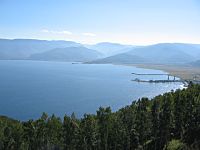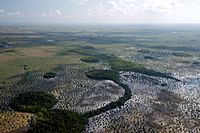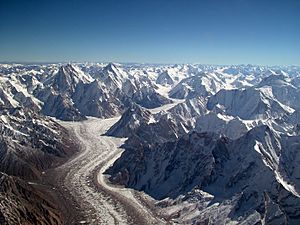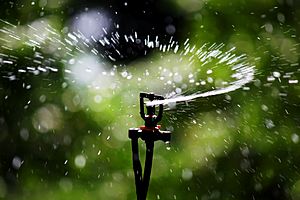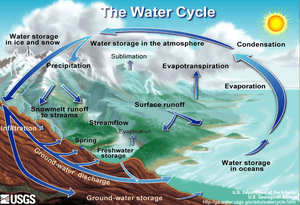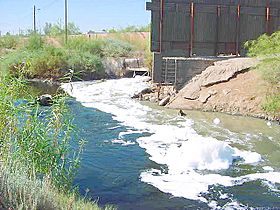Fresh water facts for kids
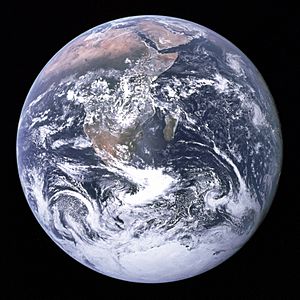
Fresh water is water that does not have a lot of salt in it. When people talk about fresh water, they usually mean water from lakes, rivers, snow, and ice. This is different from the salty water found in oceans and seas.
Not all fresh water is safe to drink. It can be polluted with harmful bacteria or poisonous chemicals. Water from a tap is usually tested and treated to make it safe. In some places, water needs to be boiled first to kill germs before drinking.
Fresh water that is safe to drink is called 'potable water'. Sometimes, salt water can be turned into drinkable water through a process called Desalination.
Contents
Where Does Fresh Water Come From?
Almost all fresh water comes from rain and snow falling from the sky. This water can pick up things from the air as it falls. For example, in busy areas, rain can become acidic because of chemicals from cars and factories. This is called acid rain and can harm lakes and rivers.
Fresh water can be found in different places:
- Still water: This includes ponds, lakes, and swamps.
- Running water: This means rivers and streams.
- Underground water: This water flows through rocks and aquifers deep below the ground.
Most of the fresh water on Earth is actually frozen in ice caps and glaciers.
How Much Fresh Water Is There?
Water is super important for all living things. Most plants and mammals need fresh water to survive.
Here's how Earth's water is divided:
- About 97% of all water on Earth is salty water found in oceans and seas.
- Only about 2.5% to 2.75% is fresh water.
- Most of this fresh water (1.75% to 2%) is frozen in glaciers, ice, and snow.
- About 0.5% to 0.75% is fresh groundwater and water in the soil.
- Less than 0.01% is surface water in lakes, swamps, and rivers.
Large freshwater lakes hold most of the surface fresh water. For example, the African Great Lakes, Lake Baikal in Russia, and the North American Great Lakes hold a lot of it.
How Do Animals Live in Fresh Water?
Living in fresh water can be tricky for some animals because their bodies need to balance the amount of water inside them. For example, freshwater fish have special kidneys that help them get rid of extra water.
Some amazing fish, like salmon and eels, can move between fresh water and salty water. Their bodies change to adapt to the different salt levels.
Even some sea birds and animals like the marine iguana have special ways to get rid of extra salt from their bodies, often through glands near their noses.
Why Is Fresh Water So Important?
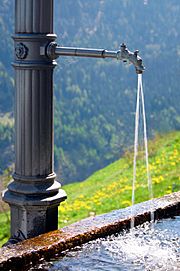
Fresh water is a vital natural resource. All ecosystems need it to survive. Humans use a lot of fresh water for things like farming and factories. This can sometimes harm the environment downstream. Chemicals and oil spills can also seriously pollute fresh water.
Only a tiny amount of the world's water, about 0.003%, is fresh and unpolluted.
Fresh Water and Farming
Farming uses the most fresh water of any human activity. When land is changed for farming, like removing trees, it affects how fresh water flows. While this can help store more water in the soil for crops, using too much water can dry up local freshwater sources and harm ecosystems. For instance, in Australia, too much water used for farming has put a third of the land at risk of becoming salty.
Is There Enough Fresh Water?
Fresh water is a renewable resource, meaning it can be replaced. This happens through the water cycle: water evaporates from seas, lakes, and land, forms clouds, and then falls back as rain or snow.
However, if people use more fresh water than nature can replace in a certain area, it can lead to water shortages. This can damage the environment around them.
Why Is Fresh Water Becoming Limited?
The world's population is growing, and each person is using more water. This puts a lot of stress on our limited supply of clean fresh water.
Also, Water pollution and a process called eutrophication (where too many nutrients cause algae to grow, using up oxygen) reduce the amount of fresh water available. Climate change also affects water quality, quantity, and when it's available.
The Future of Fresh Water
Many parts of the world already struggle with not having enough water. Because the population keeps growing and people use more water, this problem is expected to get worse. A lack of water in the future would be very bad for people. It would affect everything from cleanliness to overall health and even how much food we can grow.
Related pages
|
See also
 In Spanish: Agua dulce para niños
In Spanish: Agua dulce para niños



